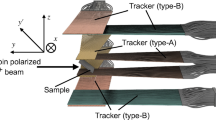Abstract
ForμLCR with slow polarization transfer, the weak resonance signals can be strengthened by delaying the positron observation period, for pulsed and chopped muon beams. Furthermore, the sensitivity to drifts can be reduced or eliminated by using the ratios of late to earlye + counts. These possibilities for using time information are discussed quantitatively.
Similar content being viewed by others
References
M. Leon,Phys. Rev. B 46 (1992) 6603.
P. O. Egan, inProc. of the Workshop on Muon Science and Facilities at Los Alamos (R. H. Heffner, Ed.), Los Alamos National Laboratory report LA-9582-C (1982), p. 29; G. zu Putlitz,Comments At. Mol. Phys. 1 (1969) 74. The benefit of increasedμLCR signal for delayede + observation period was anticipated by S. F. J. Cox,J. Phys. C 20 (1987) 3187, Fig. 66.
Author information
Authors and Affiliations
Rights and permissions
About this article
Cite this article
Leon, M. Using time information in μLCR spectroscopy: Older muons are wiser. Hyperfine Interact 87, 1123–1127 (1994). https://doi.org/10.1007/BF02068514
Issue Date:
DOI: https://doi.org/10.1007/BF02068514




